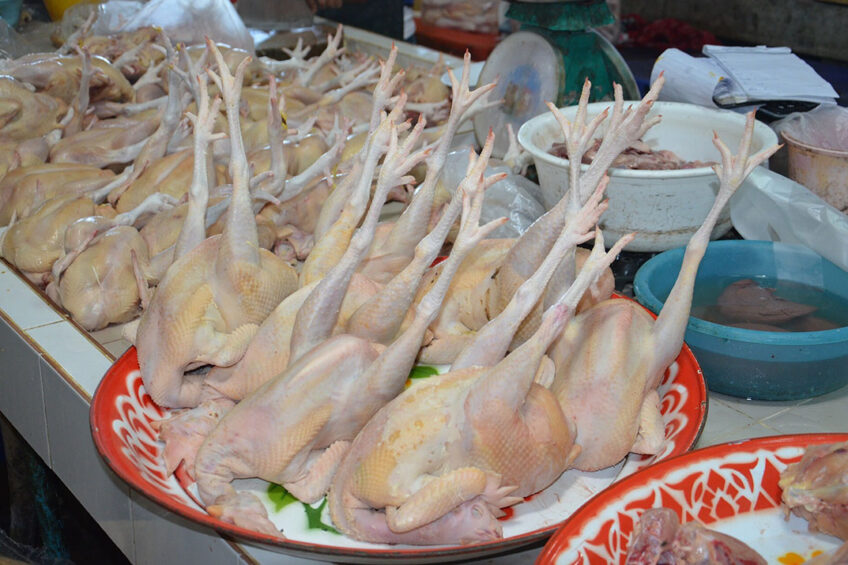Slow recovery for Thailand’s poultry market

Chicken meat production in Thailand is expected to increase by about 1% in 2021 and 3% in 2022, while domestic consumption slowly begins to increase alongside a gradual economic recovery.
Although well below the average annual growth rate of chicken meat production prior to the Covid-19 outbreak, total chicken meat production in Thailand increased by about 1% in the first half of 2021. A notable increase was seen particularly in cooked chicken meat (an increase of around 6% in the first half of 2021), while uncooked chicken meat production increased by just 0.3%.
An increase in the prices of feed grains resulted in high production costs for broiler farmers in the first half of 2021, increasing 12% from the same period in 2020. The price of corn increased 8%, and soybean meal 21%. Thai feed mill industries filed a petition with the government in June 2021 to reduce tariffs on imported feed ingredients. The average tariff rate on imported feed ingredients is the highest among Southeast Asian countries. It is forecast that chicken meat production in 2022 will increase around 3% from 2021 in line with a gradual recovery in domestic consumption and exports of chicken meat.
China audits processing facilities
It is expected that the Chinese government will approve more chicken meat export facilities in 2022. The auditing process was disrupted by the Covid-19 pandemic. The Chinese government has been auditing chicken meat processing facilities in Thailand since 2017 after China banned Thai chicken meat imports due to an avian influenza outbreak in the country in 2004. China lifted the ban in 2018 and approved 9 export facilities. China has now approved 22 Thai chicken meat export processing facilities out of 31 that have been certified by the Thai Department of Livestock Development.
From 20 million to 11,000 tourists
In the first half of 2021, domestic consumption of chicken meat, which accounts for around 70% of total chicken meat production, increased 4% from the same period in 2020, rebounding from a 3-4% contraction during the Covid-19 outbreak in 2020. Strict government measures to control the spread of Covid-19 has severely affected the food service industry. The Covid-19 pandemic and a halt in tourism has also had a significant effect. Food service activities in the first half of 2021 declined around 14% from the same period in 2020, and the number of foreign tourists declined to around 11,200 tourists from 882,000 in the same period in 2020, and around 20 million tourists prior to the pandemic.
CP Foods revs up cage-free production
Charoen Pokphand Foods (CPF) is set to rev up cage-free egg production to meet the increasing demand from the food service industry and consumers concerned about animal welfare. Read more…
It is expected that in 2021, domestic consumption of chicken meat will increase 1% from 2020. Meanwhile, food service activities will likely resume in the last quarter of 2021 as the Thai government eases Covid-19 measures. Domestic chicken meat consumption is expected to further increase 3% in 2022.
Significant increase of cooked chicken
Chicken meat exports increased to 519,228 mt in the first half of 2021, up 6% from the same period in 2020. Cooked chicken meat exports account for about 58% of total chicken meat exports and increased 6% in that time. Thailand exported around 90% of its cooked chicken meat products to Japan (52%), the UK (25%) and the EU (11%). Cooked chicken meat exports to the EU increased significantly by 29% in the first half of 2021 as Thailand benefited from the new EU’s tariff rate quota after Brexit in 2021. Cooked chicken meat exports to Japan and the UK increased 3% each due to their gradual economic recoveries from the Covid-19 outbreak.
Increasing uncooked chicken meat exports
Exports of uncooked chicken meat (excluding paw) account for around 35% of total chicken meat exports and increased 9% in the first half of 2021. Uncooked chicken meat exports to Japan, which accounted for 55% of total uncooked chicken meat exports, increased 25%. This more than offset the reduced uncooked chicken exports to China (15% of total uncooked chicken meat exports) which resulted from a gradual recovery in China’s production of poultry and swine. Salted poultry exports (7% of total chicken meat exports), declined 11% in the first half of 2021 from the same period in 2020, due to competition from Brazil and Ukraine. It is expected that total chicken meat exports in 2021 will increase only around 2% from 2020, and 3% in 2022. This chicken meat export growth is still far below the 5-year average annual export growth of around 10% prior to the pandemic.
A highly protected market
Thailand is a highly protected market where the government only allows the importation of certain types of poultry meat. The Thai government practically bans US chicken meat products, and high import tariffs (30% for chilled or frozen uncooked meat and 40% for cooked chicken meat) and a discriminatory import permit fee on uncooked products (about US$ 208/mt) help to protect the domestic market from imports.
The information in this article has been extracted from a United States Department of Agriculture Foreign Agricultural ServiceGlobal Agricultural Information Network report.












